Excerpts from Jim Conrad's
Naturalist Newsletter
Entry from field notes dated August 30, 2023, taken in Los Mármoles National Park, Hidalgo state, MÉXICO, about 1km upslope along road heading eastward out of the town of Trancas {on maps designated "Morelos (Trancas)"} toward Nicolás Flores; limestone bedrock; elevation ±2,100m (6900ft); (N20.80253°, W99.25756°)
GONOLOBUS GRANDIFLORUS
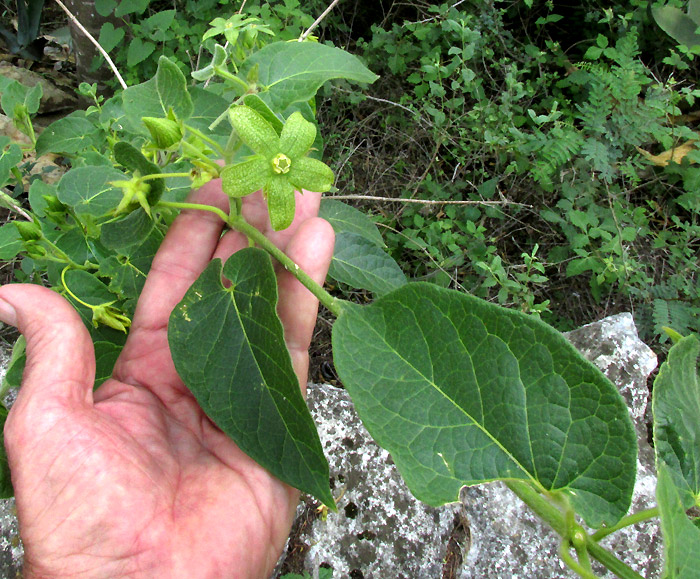
The above surprisingly large, green flower adorned a vine twining on a barbed wire fence along the road. Even at a distance, the vine's somewhat heart-shaped leaves arising opposite one another, and the blossom's unique general appearance, suggested one of the many species of "climbing milkweeds" -- members of the milkweed subfamily, the Asclepiadoideae, of the Dogbane Family, the Apocynaceae.
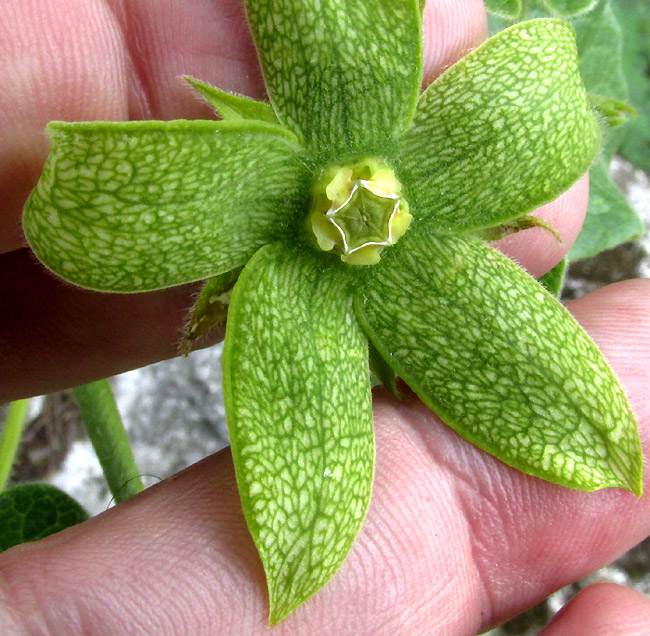
Milkweeds produce some of the most highly modified of all flower types. Their most distinctive feature is the gynostegium, consisting of the flower's male stamens fused with the female stigma, in the picture above comprising the flower's center. The green, star-shaped item is the gynostegium's stylar head, the style being the ovary's neck topped with a stigma. The flattish, yellowish items arising between the stylar head's arms are staminal appendages, parts of the stamens. An important field mark for this species' identification is the flower petals' reticulating patterns of white spots amid green veins.

Above, the yellow staminal appendages are better seen. Basically they are outgrowths of the stamens' flattened-out filaments. The black specks between the staminal appendages are pollinia, sometimes known as half-anthers. Pollinia are tiny, waxy masses of stuck together pollen grains. The gynostegium's structure makes sense when you think of a leg of an insect pollinator wandering across the gynostegium entering a gap formed by adjacent staminal appendages. The appendages channel the leg toward a black pollen-mass, the pollinarium, on which the leg snags. When the leg is pulled free, the pollen-mass goes with it, and ideally later is deposited on the stigma head of another flower of this species, accomplishing pollination.
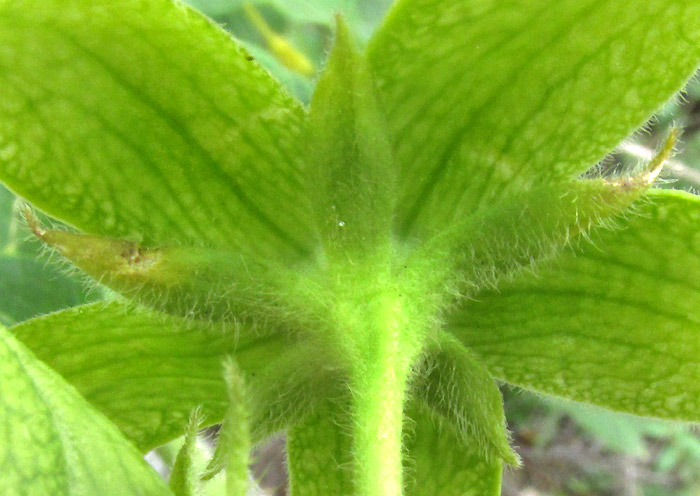
Seen from below, the flower's five conspicuously soft-hairy sepals are seen arising from a similarly hairy pedicel.
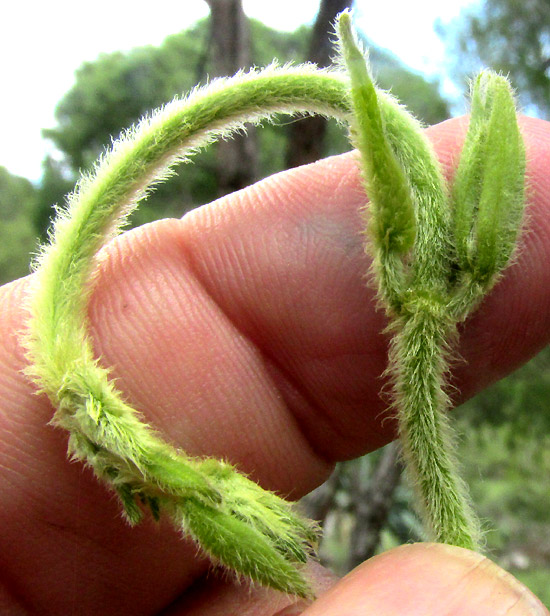
The vine's growing tips and emerging leaves are shaggy with soft, white hairs.
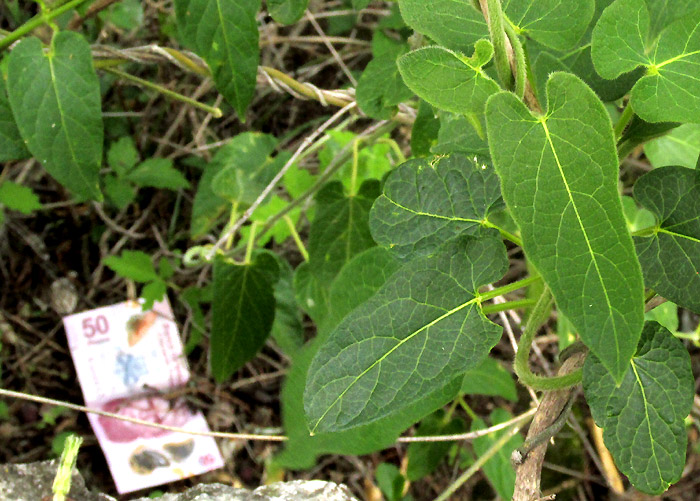
The above picture was meant to show the vine's leaf shape, but the Mexican 50-peso bill steals the show. The remarkable, even surreal, aspect is that I didn't see the bill when taking the picture, and the money lay on ground beyond the fence, well away from houses and people passing on the road. It's just one of those weird occurrences one wonders about, and I hope someone nice eventually finds it. Here's what the vine's habitat looked like, with my green backpack leaning against the fencepost beneath it:

Our vine looks very much like the similarly large-flowered Gonolobus uniflorus encountered last year in the mountains of southern Querétaro state. The most obvious difference between the two species is that the Querétaro plant's flower petals displayed no reticulated pattern of white spots amid green veins. Otherwise, the two species are strikingly similar, and it's clear that our vine is another species of the genus Gonolobus.
No detailed study has been made of the Gonolobus species of upland central Mexico. By comparing our plant with pictures on the Internet, and consulting the 2022 study by José Luis Villaseñor and others entitled "Riqueza y distribución de la flora vascular del estado de Hidalgo, México" -- a detailed list of vascular plants of Hidalgo state -- it's apparent that our vine must be...
As I was photographing the vine, a fellow walked by and started talking. He said that in this area the vine is called chivo, the name applied to a young goat, or kid. He also said that people liked to eat the young fruit pods, after roasting them among the embers of a wood fire. In fact, one species of this genus is famously edible among tropical American country folks, Gonolobus edulis, and on our page for that species you can see a pod charred by campfire embers, a pod that I myself ate, finding its soft flesh tasting pleasantly fungusy. Another common name often used in this area for our vine is chayote manso, the chayote being a much-grown, green, squash fruit, and the word manso variously meaning domesticated, tame, inoffensive and such.
This species was quite common along a certain stretch of the road, but once a little elevation was gained, it completely disappeared and was not seen again during a whole week of botanizing in the higher elevations.
entry from field notes dated January 17, 2023, taken on trail up the southeast-facing slope of Peña de Bernal on the northwestern side of Bernal, elevation ±2,220m (7280 ft); bedrock of intrusive, igneous dacite rock, similar to granite; Querétaro state, MÉXICO, (N20.748°, W99.949°)
FRUITS OF GONOLOBUS GRANDIFLORUS

During the dry season after a rainy season that never fully developed, the above out-of-reach fruiting vine twined among upper branches of a Desert Olive tree. The view beyond the vegetation shows the flatlands southward. The distant white items are greenhouses growing tomatoes, chili peppers, lettuce and such.
Though most of the vine's leaves have fallen off, several pairs of leaves at the vine's nodes indicate that this species bears opposite leaves. The leaves themselves show backward-projecting lobes at their bases, so the leaves are slenderly heart-shaped, or cordate. Opposite, cordate leaves on a vine bring to mind the "climbing milkweeds" of the Dogbane Family, the Apocynaceae. Moreover, the follicle-type fruiting pods -- follicles being dry fruits composed of only one compartment, the compartment containing two or more seeds, and the mature fruit splitting along one side to release seeds -- look like the group of climbing milkweeds known as the anglepods, genus Gonolobus.
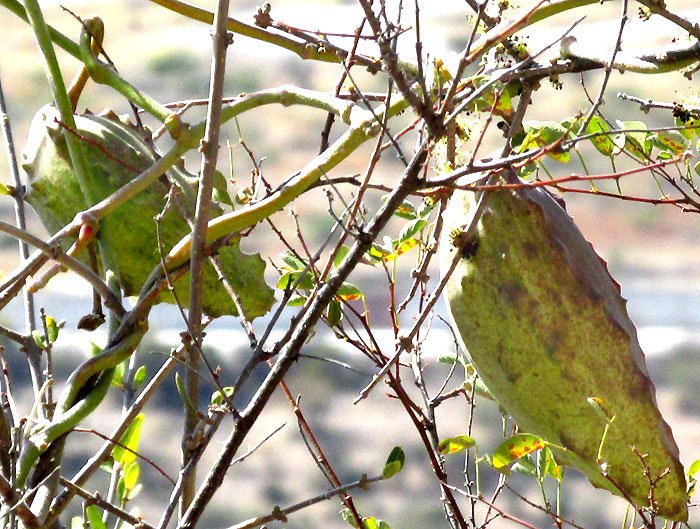
Up closer, the fruits' modest angularity is easier observed, as are the fruits' short, broad-based, pointed tubercles, and the green skins' ample dark splotches.
Here in the central uplands of Mexico, no comprehensive study of the Dogbane Family of Querétaro state is available. However, a list of documented species for Guanajuato State, just to our west, entitled "Documento Técnico Base del Inventario de Especies Vegetales Nativas del Estato de Guanajuato," lists three Gonolobus species. Also, a list of documented species for Hidalgo State, just to our east, entitled "Riqueza y distribución de la flora vascular del estado de Hidalgo, México," lists seven Gonolobus species. All three species in Guanajuato also occur in Hidalgo.
On the Internet, of pictures of fruits and leaves of the seven Hidalgo species, the best I can see is that only two species display features matching those seen in our pictures: Gonolobus grandiflorus and G. chloranthus. I couldn't easily separate the two species, but now I see that as of this writing the Kew Plants of the World database considers the name Gonolobus grandiflorus to be a synonym of Gonolobus chloranthus. However, iNaturalist and our Mexican experts, recognize what's shown here to be Gonolobus grandiflorus.